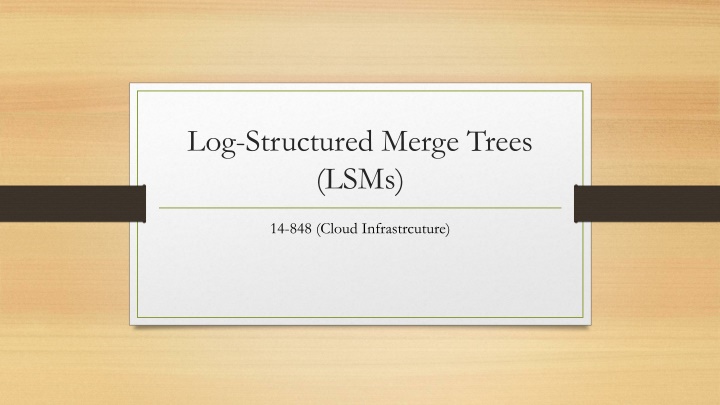
Efficient High-Throughput Data Updates with Log-Structured Merge Trees
A system supporting high-throughput updates with a large data volume exceeding main memory capacity utilizes Log-Structured Merge Trees (LSMs). Updates are collected and batched in memory, then spilled to disk when memory is near full. Merging of in-memory and on-disk data occurs to optimize storage and query performance, with compaction recovering storage space by merging updates and deleting tombstoned records.
Download Presentation

Please find below an Image/Link to download the presentation.
The content on the website is provided AS IS for your information and personal use only. It may not be sold, licensed, or shared on other websites without obtaining consent from the author. If you encounter any issues during the download, it is possible that the publisher has removed the file from their server.
You are allowed to download the files provided on this website for personal or commercial use, subject to the condition that they are used lawfully. All files are the property of their respective owners.
The content on the website is provided AS IS for your information and personal use only. It may not be sold, licensed, or shared on other websites without obtaining consent from the author.
E N D
Presentation Transcript
Log-Structured Merge Trees (LSMs) 14-848 (Cloud Infrastrcuture)
Scenario A system is needed to support high-throughput updates The total data volume is larger than the main memory budget Writes to secondary storage occur more quickly and efficiently when batched than when written individually. For example, writing a whole block of data at a time amortizes disk seek and rotational delay Sorting and indexing data in main memory can be done relatively efficiently causing relatively little delay.
Collect and Batch Updates In Memory Collect updates in memory Sort them somehow Sorted string list Tree, Etc. Updates possible to in-memory values But, once a value is written to disk, it stays written Queries will need to find all records and merge Tombstone deletes
Spill From Memory To Disk As memory budget approaches full, spill them to disk Write out entire sorted string table Write out a subtree, then remove and prune it in memory Each dump from memory to disk forms a run of some kind Runs are time ordered
Merge, Idea #1 Possibility #1: Merge portions of in-memory data structure into on-disk data structure as spilled Common when pruning in-memory trees and merging into on-disk trees Slows the freeing of memory
Merge Idea #2 Possibility #2: Dump from memory into new run , i.e. data structure in secondary storage Maintain in-memory Bloom Filters, one per disk run, to support queries Upon query, check Bloom Filters Then check on-disk runs only where Bloom filters indicated possible match Merge updates disk data structures in background By similar tree pruning, if tree By merging files into new files if tables Delete then update Bloom Filter, since false positives aren t fatal
Merge Idea #3 Compaction occurs as part of the merges Deletes Tombstoned records Merges multiple updates into one Recovers storage from merged updates and deleted values
Log-Structured Merge Trees (LSMs) When we spill subtrees or branches from an in-memory tree into a tree in secondary storage, this strategy is known as a Log-Structured Merge Tree (LSM) Tree The in-memory tree is often known as C0 and the tree in secondary storage is known as C1. If there are more levels of trees (not within a tree), they are known as C1,C2,etc.
Memtable, SSIndex, SSTable Common idiom in practice Memtable in main memory contains sorted values and likely sorted <key, offset> index. When spilled to disk is divided into SSTables and SSIndexes written separately Indexes or Bloom Filters kept in memory Merging in background when threshold met in terms of number of tables, etc. Merges perform compaction Write-Ahead logs used to aid recovery. Used in some form by Cassandra, Hbase, LevelDB, BigTable, Etc.
Summary Overall strategy Fill memory Spill to disk Search disk runs until they can be merged Use Bloom Filters to minimize unproductive searches Updated in-memory, but merge independent changes once on disk. The overall strategy is sound even if it Does not involve trees, for example by using sorted string tables, and Even if it leaves a forest of data structures to be searched after consulting a Bloom Filter.
